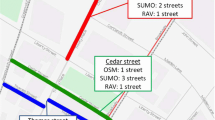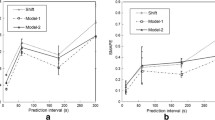Abstract
Over downtown and highway road scenarios several applications have been proposed to enhance the quality of driving trips there. Safety, efficiency and entertainment services are provided to vehicles through several advanced technologies. Many of these applications require accurate investigation of the traffic characteristics and distributions over the area of interest in order to successfully provide the targeted services. To mention a few, path recommendation protocols, traffic light scheduling algorithms and driving assistance techniques need specific, detailed and accurate traffic distribution reports regarding the investigated area of interest. Several traffic prediction and evaluation protocols have been proposed in the literature using historical, visual and wireless connecting technologies to gather the real-time basic traffic data. Accuracy, delay, bandwidth consumption and high cost required equipments are the main challenges of the previous protocols. In this paper, we aim to propose a real-time traffic distribution prediction protocol (TDPP) using the vehicular network technology. The proposed protocol aims to produce accurate traffic evaluation and distribution of the investigated area of interest based on gathering the basic traffic data of some traveling vehicles there. From the experimental results we can infer that the TDPP protocol provides more accurate traffic evaluation in the case that only a few vehicles are equipped with wireless transceivers. Moreover, it requires less bandwidth and time to evaluate the traffic characteristics compared to traditional protocols in this field, since it only processes the basic traffic data of the small selected set of vehicles there.







Similar content being viewed by others
References
Ahmad M, Chen Q, Khan Z, Ahmad M, Khurshid F (2019) Infrastructure based vehicular congestion detection scheme for V2I. Int J Commun Syst 32(3):38–77
Ahmed NU, Yeap TH (2018) Optimum management of urban traffic flow based on a stochastic dynamic model. IEEE Trans Intell Transp Syst 20(12):4377–4389. https://doi.org/10.1109/TITS.2018.2884463
Al Mallah R, Quintero A, Farooq B (2017) Distributed classification of urban congestion using VANET. IEEE Trans Intell Transp Syst 18(9):2435–2442
Arel I, Liu C, Urbanik T, Kohls AG (2010) Reinforcement learning-based multi-agent system for network traffic signal control. IET Intell Transp Syst 4(2):128–135
Cousineau D, Chartier S (2010) Outliers detection and treatment: a review. Int J Psychol Res 3(1):58–67
Dia H (2001) An object-oriented neural network approach to short-term traffic forecasting. Eur J Oper Res 131(2):253–261
Kachroo Pushkin, Al-Nasur Sadeq J (2008) Sabiha Amin Wadoo, and Apoorva Shende. Feedback control of crowd evacuation: pedestrian dynamics. Springer Science and Business Media, Berlin
Kong X, Xu Z, Shen G, Wang J, Yang Q, Zhang B (2016) Urban traffic congestion estimation and prediction based on floating car trajectory data. Future Gener Comput Syst 61:97–107
Krajzewicz D, Brockfeld E, Mikat J, et al (2005) Simulation of modern traffic lights control systems using the open source traffic simulation SUMO. In: Proceedings of the 3rd industrial simulation conference: EUROSIS-ETI, pp 299–302
Lin S, Pan TL, Lam WHK, Zhong RX, De Schutter B (2018) Stochastic link flow model for signalized traffic networks with uncertainty in demand. IFAC PapersOnLine 51(9):458–463
Li F, Gong J, Liang Y, Zhou J (2016) Real-time congestion prediction for urban arterials using adaptive data-driven methods. Multimedia Tools Appl 75(24):17573–17592
Rezende CG, Pazzi RW, Boukerche A (2009) An efficient neighborhood prediction protocol to estimate link availability in VANETs. In: Proceedings of the 7th ACM international symposium on Mobility management and wireless access, pp 83-90
Rosenbaum D, Leitloff J, Kurz F, et al (2010). Real-time image processing for road traffic data extraction from aerial images. In: Proceedings of ISPRS commission VII symposium, pp 372–388
Urazghildiiev I, Ragnarsson R, Ridderstrom P et al (2007) Vehicle classification based on the radar measurement of height profiles. IEEE Trans Intell Transp Syst 8(2):245–253
Wang L, Zhou Z (2017). Congestion prediction for urban areas by spatiotemporal data mining. In: 2017 International conference on cyber-enabled distributed computing and knowledge discovery (cyberC): IEEE, pp 290–297
Wang Z, Wan Q, Qin Y et al (2019) Intelligent algorithm in a smart wearable device for predicting and alerting in the danger of vehicle collision. J Ambient Intell Humaniz Comput 11:3841–3852. https://doi.org/10.1007/s12652-019-01609-3
Wang X, Yang LT, Kuang L, Liu X, Zhang Q, Deen MJ (2019) A tensor-based big-data-driven routing recommendation approach for heterogeneous networks. IEEE Netw 33(1):64–69
Yaqoob S, Ullah A, Akbar M, Imran M, Shoaib M (2019) Congestion avoidance through fog computing in internet of vehicles. J Ambient Intell Humaniz Comput 10(10):3863–3877
Younes MB, Boukerche A (2015) A performance evaluation of an efficient traffic congestion detection protocol (ECODE)) for intelligent transportation systems. Ad Hoc Netw 24:317–336
Zhong RX, Sumalee A, Pan TL, Lam WHK (2013) Stochastic cell transmission model for traffic network with demand and supply uncertainties. Transportmetrica A Transp Sci 9(7):567–602
Author information
Authors and Affiliations
Corresponding author
Additional information
Publisher's Note
Springer Nature remains neutral with regard to jurisdictional claims in published maps and institutional affiliations.
Rights and permissions
About this article
Cite this article
Younes, M.B. Real-time traffic distribution prediction protocol (TDPP) for vehicular networks. J Ambient Intell Human Comput 12, 8507–8518 (2021). https://doi.org/10.1007/s12652-020-02585-9
Received:
Accepted:
Published:
Issue Date:
DOI: https://doi.org/10.1007/s12652-020-02585-9




